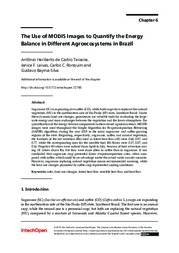The use of MODIS images to quantify the energy balance in different agroecosystems in Brazil.
The use of MODIS images to quantify the energy balance in different agroecosystems in Brazil.
Author(s): TEIXEIRA, A. H. de C.; LEIVAS, J. F.; RONQUIM, C. C.; SILVA, G. B. S. da
Summary: Sugarcane (SC) is expanding over coffee (CO), while both crops have replaced the natural vegetation (NV) in the northeastern side of São Paulo (SP) state, Southeast Brazil. Under these dynamic land-use changes, geosciences are valuable tools for evaluating the largescale energy and mass exchanges between the vegetation and the lower atmosphere. For quantification of the energy balance components in these mixed agroecosystems, MODIS images were used throughout the Simple Algorithm for Evapotranspiration Retrieving (SAFER) algorithm, during the year 2015 in the main sugarcane- and coffee-growing regions of the state. Regarding, respectively, sugarcane, coffee, and natural vegetation, the fractions of the net radiation (Rn) used as latent heat flux (?E) were 0.68, 0.87, and 0.77, while the corresponding ones for the sensible heat (H) fluxes were 0.27, 0.07, and 0.16. Negative H values were noticed from April to July, because of heat advection raising ?E values above Rn, but they were more often in coffee than in sugarcane. It was concluded that sugarcane crop presented lower evapotranspiration rates, when compared with coffee, which could be an advantage under the actual water scarcity scenario. However, sugarcane replacing natural vegetation means environmental warming, while the land use changes promoted by coffee crop represented cooling conditions.
Publication year: 2018
Types of publication: Book sections
Unit: Embrapa Environment
Observation
Some of Embrapa's publications are published as ePub files. To read them, use or download one of the following free software options to your computer or mobile device. Android: Google Play Books; IOS: iBooks; Windows and Linux: Calibre.
Access other publications
Access the Agricultural Research Database (BDPA) to consult Embrapa's full library collection and records.
Visit Embrapa Bookstore to purchase books and other publications sold by Embrapa.

